VÍDEO PARA LA EVALUACIÓN
PENPAL FRIEND

Study 15 minutes every day.
Listen to songs
Watch series or cartoons in english
Practice what we have learnt in class.
STARTER UNIT
THE ALPHABET
THE NUMBERS
- Numbers:
- 1-10: one, two, three, four, five, six, seven, eight, nine, ten.
- 11-20: eleven, twelve, thirteen, fourteen, fifteen, sixteen, seventeen, eighteen, nineteen, twenty.
- 10-100: ten, twenty, thirty, forty, fifty, sixty, seventy, eighty, ninety, a hundred.
Numbers
Numbers
MONTHS OF THE YEARS
DAYS OF THE WEEK
ALL TOGETHER NOW ( THE BEATLES )
Click on the picture and you'll find worksheets to download and print. (Pincha en las imágenes para imprimir fichas)
Story
Off to school!
UNIT 1 " AT THE CIRCUS "
Vocabulary
Activo: curly hair, wavy hair, straight hair, blond hair,
glasses, ponytail, moustache, beard
Repaso: black, He’s got (curly hair). He hasn’t got (wavy hair)
Repaso: black, He’s got (curly hair). He hasn’t got (wavy hair)
curly hair: pelo rizado
straight hair: pelo liso
long hair: pelo largo
short hair: pelo corto
dark hair: pelo moreno
fair hair: pelo rubio
glasses: gafas
moustache: bigote
beard: barba
ponytail: coleta
GRAMMAR
Verb have got: Tener
Affirmative
| Forma corta | |||||
| I | have got | I've got | yo tengo | ||
| you | have got | you've got | tú tienes/vosotros tenéis | ||
| he | has got | he's got | él tiene | ||
| she | has got | she's got | ella tiene | ||
| it | has got | it's got | animal o cosa tiene | ||
| we | have got | we've got | nosotros tenemos | ||
| they | have got | they've got | ellos tienen |
Negative
| Forma corta | ||||
| I | have not got | I haven't got | yo no tengo | |
| you | have not got | you haven't got | tú no tienes/vosotros no tenéis | |
| he | has not got | he hasn't got | él no tiene | |
| she | has not got | she hasn't got | ella no tiene | |
| it | has not got | it hasn't got | animal o cosa no tiene | |
| we | have not got | we haven't got | nosotros no tenemos | |
| they | have not got | they haven't got | ellos no tienen |
Interrogative
| Have I got? | ¿Yo tengo? |
| Have you got? | ¿Tú tienes? |
| Has he got? | ¿Él tiene? |
| Has she got? | ¿Ella tiene? |
| Has it got? | ¿Animal o cosa tiene? |
| Have we got? | ¿Nosotros tenemos? |
| Have they got? | ¿Ellos tienen? |
Short Answer
Yes, I have Si, tengo No, I haven't No, no tengo
Yes, he has Si, él tiene No, he hasn't No, no tiene
Yes, she has Si, ella tiene No, she hasn't No, ella no tiene
Yes, we have Si, nosotos tenemos No, we haven't No, nosotros no tenemos
INTERACTIVE BOOK ( HAVE GOT )
INTERACTIVE BOOK ( PHYSICAL DESCRIPTION)
Mark's family.
Actividad online. La primera parte, para practicar el vocabulario de la
familia (reading). La segunda parte, para practicar la descripción
simple (eyes and hair). Reading and writing.
Affirmative
He has got / He's got short hair: Él tiene pelo corto.
She has got / She's got long hair: Ella tiene pelo largo.
Negative
He hasn't got glasses: Él no tiene gafas.
She hasn't got a ponytail: Ella no tiene coleta.
Interrogative
Has he got a moustache? : ¿Tiene él bigote?
Has she got fair hair? : ¿Tiene ella pelo rubio?
Short answers
Yes, he / she has : Si
No, he / she hasn't: No
| Describing people Describing people Describing people Describing people Describing people Describing people |
Review
What's he/ she wearing?: ¿Qué lleva puesto?
He's / She's wearing a coat, a hat, etc. : el / Ella lleva puesto
un abrigo, un sombrero, etc...
UNIT 2
VOCABULARY
GRAMMAR
PRESENT CONTINUOUS(Se usa para expresar lo que estamos haciendo justo en el momento actual)
Verb To Be + V-ing
Verb To Be + V-ing
| ESTRUCTURA - SUJ (I, YOU, WE, THEY) I AM V-ing |
XX | ESTRUCTURA - SUJ (HE, SHE, IT) |
| YOU ARE V-ing YOU AREN'T V-ing ARE YOU V-ing? Resp. af.: —YES, I AM. Resp. neg.: —NO, I'M NOT. WE ARE V-ing THEY ARE V-ing |
HE/SHE/IT IS V-ing HE/SHE/IT ISN'T V-ing IS HE/SHE/IT V-ing? Resp. af.: —YES, HE IS. Resp. neg.: —NO, HE ISN'T. |
|
| WHAT ARE YOU DOING? | WHAT IS HE DOING? | |
| Examples | Examples | |
| I am taking photos in the countryside. You aren't eating a sandwich. Are you playing to the park? —Yes, I am. We are acting at the theatre. Are they listening to the CD player? —No, they aren't. |
He is doing his homework. She isn't swimming in the beach. Is he studing in his bedroom? —Yes, he is. Is she singing in the party? —No, she isn't. |
Present continuous
Present continuous
Present continuous
Present continuous
Present continuous
Present continuous
Present continuous
Present continuous higher
Present continuous higher
INTERACTIVE BOOK ( PRESENT CONTINUOUS)
VÍDEO ( WHAT ARE YOU DOING?)
HOUSEWORK ( GAMES, ACTIVITIES )
PRESENT CONTINUOUS EXERCISES
UNIT 3
Vocabulary
Station ( train, bus, police, fire )
Sports centre
Museum
Bank
Theatre
Shopping centre
Restaurant
Cathedral
Shop
Supermarket
BridgeShop
Supermarket
School
Hospital
Park
GRAMMAR : THERE IS / THERE ARE
PREPOSITIONS OF PLACE I
Preposition of Place
Observe the map and choose the correct preposition.

1. The music store is Santos Dumont Street and Rosa e Silva Avenue.
2. The hospital is the pet shop.
3. The toy store is the music store and the restaurant.
4. The supermarket is the restaurant.
5. The fast food restaurant is Amélia Street.
6. The bookstore is the supermarket.
7. The school is Amélia Street and Rosa e Silva Avanue.
9. The pet shop is Amélia Street.
10. The flower shop is Santos Dumont Stree.

restaurant
park
school
bridge
bank
airport: aeropuerto
harbour: puerto
road: carretera
shopping centre: centro comerical
sports centre: centro deportivo
church: iglesia
swimming pool: piscina
Prepositions
opposite
in front of
behind
next to
Verbo haber
THERE + VERBO TO BE : HAY
THERE IS : THERE'S: HAY UNO/A (SINGULAR)
THERE ARE : THERE'RE: HAY VARIOS/AS(PLURAL)
There´s a shop.(Hay una tienda) .
THERE + VERBO TO BE : HAY
THERE IS : THERE'S: HAY UNO/A (SINGULAR)
THERE ARE : THERE'RE: HAY VARIOS/AS(PLURAL)
There´s a shop.(Hay una tienda) .
Is there a school? (¿Hay un colegio?)
Yes there is. (Si)
Yes there is. (Si)
No, there isn´t. (No)
There are cinemas. (Hay cines)
There aren't hospitals. No hay hospitales)
Are there museums? (¿Hay museos?)
Yes, there are (Si) / No, there aren't (No)
Preguntar y contestar acerca de dónde se encuentran los lugares de la ciudad.
WHERE + VERBO TO BE : ¿DÓNDE ESTÁ/N?
SUJETO + VERBO TO BE + PREPOSICIÓN + LUGAR
There are cinemas. (Hay cines)
There aren't hospitals. No hay hospitales)
Are there museums? (¿Hay museos?)
Yes, there are (Si) / No, there aren't (No)
Preguntar y contestar acerca de dónde se encuentran los lugares de la ciudad.
WHERE + VERBO TO BE : ¿DÓNDE ESTÁ/N?
SUJETO + VERBO TO BE + PREPOSICIÓN + LUGAR
Where is the cinema? (¿Dónde está el cine?)
The cinema is between the shop and the bank.
(El cine está entre la tienda y el banco)
Exercises 1
Exercises 2
Exercises 3
Exercises 4
Exercises 5
Exercises 6
Exercises 7
UNIT 4
Things we like doing
Vocabulary
collecting stickers: coleccionar pegatinas
going to museums: ir a museos
painting pictures: pintar dibujos
using the computer: usar el ordenador
dancing: bailar
shopping: ir de compras
playing frisbee : jugar al frisbee
playing board games: jugar a juegos de mesa
playing golf: jugar al golf
taking photos: hacer fotos
doing exercises: hacer ejercicio
skipping: saltar a la comba
playing cards: jugar a las cartas
talking to friends: charlas con amigos
playing football
playing basketball
playing tennis
playing computer games
rollerskating: patinar
skateboarding: montar en monopatín
playing the violin
playing the drums
playing the piano
playing the recorder
reading comics
riding a horse
riding a bike
in the morning: por la mañana
in the afternoon: por la tarde
in the evening: al anochecer
at night: por la noche
Structures
Para expresar si nos gusta realizar una actividad se usa el verbo gustar(like) en presente simple seguido de un verbo terminado en ing. Ej. I like skipping.
Present Simple
Affirmative
Sujeto + like/likes+ Verbo terminado en ing
I like shopping
You like playing cards
He,She,It likes rollerskating (a la 3º p.s. se le añade s).
We like playing the piano
You like taking photos
They like playing golf
Negative
Sujeto+don't/doesn't+like+Verbo terminado en ing
I don't like shopping
You don't like playing cards
He, she, It doesn't like rollerskating(con la 3º p.s.se usa doesn't y no se añade la s a like)
We don't like playing the piano
you don't like taking photos
They don't like playing golf
Interrogative
Do/Does+sujeto+like+Verbo terminado en ing?
Do you like shopping?
Does he,she,it like rollerskating?(con la 3º p.s.se usa does y no se añade la s cuando va interrogativo)
Do you like taking photos?
Do they like playing golf?
Short Answers
1º p. Yes,I /we do / No, I/we don't
3º p. Yes, he/she/it does / No, he/she/it doesn't
Exercise 1
Exercise 2
Exercise 3
Exercise 4
Exercise 5
Exercise 6
Sentences
Examples
1)Me gusta montar a caballo pero no me gusta hacer fotos.
I like riding a horse but I don't like taking photos.
2) A ella le gusta jugar a las cartas y saltar a la comba por la mañana.
She likes playing cards and skipping in the morning.
3) ¿Te gusta leer comics? Si.
Do you like reading comics? Yes, I do.
4) ¿Le gusta a él montar en monopatín? No.
Does he like skateboarding? No, he doesn't
Translate the sentence
Me gusta tocar el violín pero no me gusta jugar al golf.
A ella le gusta montar en bici pero no le gusta jugar al fútbol.
A mi me gusta hacer fotos y jugar al frisbee por la tarde.
A él le gusta hacer ejercicio y jugar a juegos de mesa al anochecer.
¿Te gusta charlas con amigos? Si.
¿Le gusta a él jugar a las cartas? No.
UNIT 5 ( MY DAY )
VOCABULARY ( DAILY ROUTINES)
I..... wake up, get up, get dressed, have breakfast, wash my face, brush my teeth, comb my hair, make my bed, go to school ( by bus, on foot....)/ start school, go home/finish school, have lunch, do my homework, play ( computer, friends...), feed my pet, have a shower, have dinner, wash the dishes ( housework), watch television, read a book and go to bed.
TIME
Para preguntar a qué hora se hace algo habitualmente se añade What time delante de Do o Does, para responder se empieza con At. Si lo que me pregunta es qué hora es en este momente se empieza con It is.
What time do you do your homework? At five o'clock.
What time is it? It is half past four.
Present simple Se usa para expresar nuestras rutinas diarias.
Forma afirmativa.
Se
forma con el pronombre + el verbo (I read: Yo leo), la forma verbal
nunca cambia, excepto en la 3º persona del singular (He, She, It).
Ésto suele suponer una dificultad, hay que acordarse de añadir una s (She reads: Elle lee).
A veces en vez de añadir s , se añade:
- es (wash - washes), cuando el verbo termina en sh.
- es (go - goes), también se añade cuando termina en o.
- ies (study - studies), cuando el verbo termina en y precedida de consonante.
Cuando el verbo es compuesto sólo se añade la s a la primera parte (gets up).
Para forma la forma interrogativa se
añade delante del pronombre Do siempre, excepto para la 3º persona del
singular (He,She It), que se le añade Does, y entonces no se le pone la
s.
Do you read? : ¿Lees tú? Does he read? : ¿Lee él?
Para la forma negativa. se coloca
Don't (contracción de Do not) entre el pronombre y el verbo. En la 3º
persona del singular (He, She, It) se cambia por Doesn't (contracción de
Does not) y tampoco se le pone la s. I don't read: Yo no leo.
She doesn't read: Ella no lee.
It se usa para animales, objetos, para hablar del tiempo, de la hora o de cosas abstractas.
Reinforce Activities
- Daily rutines – present simple
- Daily rutines exercise
- Every day activities
- Every day life
- Telling the time
- The time exercices
- Times exercice
- Times game
- Times game
- Times game
- What time is it?
- What's the time?
- What's the time?
- Habits & Routines. By Isabel Pérez.
PRESENT SIMPLE TENSE
ACTIVITY TO REINFORCE THE DIFFERENCES BETWEEN THE 1º AND 3º PERSON
TELLING THE TIME
 Reloj analógico
Reloj analógico
 |  |  |  |
| It's quarter to two. | It's two o'clock. | It's quarter past two. | It's half past two. |
| Hora analógica | Hora digital | |
| It's five o'clock. | _5:00_ | It's five o'clock. |
| It's quarter past five. | _5:15_ | It's five fifteen. |
| It's half past five. | _5:30_ | It's five thirty. |
| It's quarter to six. | _5:45_ | It's five forty-five. |
Preguntar qué hora es
- What's the time?
- What time is it?
- Respuesta: IT'S + HORA
What time is it? It's twelve o'clock.
Preguntar a qué hora sucede una acción
- What time do you -ACTION (go to bed)?
- What time does he -ACTION (go to bed)?
- Respuesta: AT + HORA
What time do you go to school? At quarter to nine.
UNIT 6 ( UNDER THE SEA )
Vocabulary:
Structures:
Verb To Be: They are (Son) - They aren’t (No son) – Are they ? (¿Son?)
birds
(aves), cats (felinos), carnivours, herbivours, omnivours, small
(pequeños), big (grandes), medium (medianos), tall (altos), short
(cortos, bajos), dangerous (peligrosos), wild (salvajes), domestic ,
funny (divertidos), in danger ( en peligro de extinción), mammal
(mamíferos), fast (rápidos), slow (lentos), brown, black…
Verb Can : They can (Pueden) - They can’t (No pueden) – Can they? (¿Pueden?):
Run (correr), walk (andar), fly (volar), swim (nadar), climb (trepar), jump (saltar)…
Verb Have got: They have got (Tienen) - They haven’t got (No tienen) – Have they got? (¿Tienen?):
Big/small
heads (cabezas grandes o pequeñas), ears (orejas ), long/short necks
(cuellos cortos o largos), legs ( patas), tails ( colas), sharp teeth
(dientes afilados), horns (cuernos), wings (alas), spots (manchas),
stripes (rayas)…
Verb To live; They live (Viven) - They don`t live (No viven) – Do they live? (¿Viven?):
In
water (en el agua), On land (en tierra), In the air (en el aire), in the
jungle (en la selva), in the forest (en el bosque), in the savannah (
en la sabana), at the zoo (en el zoo)
Ver to eat: They eat (Comen) – Do they eat? (¿Comen?) – They don’t eat (No comen):
Leaves (hojas), grass (hierba), small animals (pequeños animals), meat (carne), plants , fruit, fish (pescado)…
GAME
PRONUNCIATION
EXERCISE
Write more descriptions about another animals: monkeys, giraffes, lions, snakes, zebras, crocodiles, elephants, …
Example: Monkeys.
They
are brown, mammal and funny. They can jump and climb. They have got a
small head, long arms and a long tail. They live on land and on trees.
They eat bananas.
Fill in the gaps
In the Jungle,
the mighty jungle,
the _____ sleeps tonight.
In the _____,
the quiet jungle,
the lions _____ tonight.
Near the village,
the peaceful ______,
the lions sleeps tonight.
_____ the village,
the quiet village,
the lions sleeps tonight.
Hush ____ darling,
don't fear my darling,
the lions sleeps ______.
Hush my darling,
don't ____ my darling,
the _____ _____ _____.
Mr. BEAN´S SAFARI
REINFORCE ( ANIMALS )
Animal body parts: spots, trunk, , wings, beak, tail, tongue, , horn, , feather, fur, stripes.
- Partes del cuerpo comunes: head, ears, eyes, mouth, neck, legs. skin.
- Para completar la información: antlers, tentacles, antennae, shell.
Habitat: Serengeti, forest, jungle, ocean, sea, river, lake, North Pole, savannah, pond, mountain. On land, in water, in air.
Diet: dead animals, plankton, grass, meat, leaves, fruit.
Abilities = can/can't: jump, eat, drink, walk, run, climb, swim, dive, talk, sing. LIVE.
Adjetives: dangerous, funny, fast, slow, very colourful.
Vocabulario pasivo:
- Behavior: aquatic, domesticated, wild, endangered, extinct, hibernating, migratory, nocturnal, poisonous, social, solitary, terrestrial, territorial, venomous.
- Types: mammal, amphibian, bird, reptile, fish, insect.
Para hacer descripciones, generalmente usamos el sujeto THEY, porque describimos cómo son los animales en general (lo hacemos en plural). También por esta razón no usarmos el artículo THE delante del nombre de los animales, porque hablamos en general (decimos HIPPOS, en lugar de *THE HIPPOS*).
- DESCRIPTION:
- size (big, small, medium)
- colour
- body parts (tail, horns, wings...)
- behavior (funny, dangerous, strong, fast...)
Ejemplos:
- Lions are big cats.
- Monkeys are brown and funny.
- Rhinos have got one or two horns.
Frases sencillas para practicar size/colour/body parts.
- DIET: Usamos el verbo EAT, junto con un
sustantivo relacionado con la comida (grass, leaves, small animals,
fruit...). Según lo que comen, podemos clasificar los animales como:
- HERBIVORES
- CARNIVORES.
- Lions eat death animals.(They like eating zebra's meat).
- Lions are carnivores.
- HABITAT: Usamos el verbo LIVE, junto algunos
sustantivos o complementos del lugar (on, land, in water, in the
mountains, forest, jungle, desert, ocean...). Según donde, podemos
clasificar los animales como:
- terrestial (they live on land).
- aquatic (they live in water).
- Lions live in Africa, in the savannah.
- They are terrestial, because they live on land.
- TYPES: Usamos el verbo to BE para describir los tipos de animales (mammal, reptile, bird...).
Ejemplo:
- Lions are terrestial mammals.
- ABILITIES: Usamos el verbo CAN (o en su forma negativa, CAN'T), junto con un verbo (fly, jump, run, swim, talk, climb, dive, crawl).
Ejemplo:
- Lions can run and jump, but they can't dive.
Project
AT THE ZOO.
Proyecto de investigación sobre animales . Crear un álbum de
recortes sobre los animales trabajados . Cada uno
buscará imágenes relacionadas con su animal, y redactará un pequeño
texto descriptivo: dónde viven, qué comen, de qué color son, si tienen
pelo/plumas/piel, alas/patas/cola, y lo que puede o no pueden hacer
(correr, volar, saltar, hablar, arrastrarse, andar...).
Actividades de Ampliación
Giant Pandas: Reading and Listening Comprehension. Un cuento popular sobre cómo los pandas adquieren su color y un interesante vídeo sobre pandas gigantes salvajes, para desarrollar destrezas de lectura y comprensión auditiva.
Koalas: No Tree .... No Me. Comprensión auditiva y lectura sobre koalas. Se puede usar con el imprimible ´Animals from Down Under" para practicar las cuatro destrezas.
The Mosquito: Listening and Reading Comprehension. Un interesante vídeo de National Geographic sobre el animal favorito de nadie, el mosquito, para practicar la comprensión auditiva, y un texto sobre cómo evitar los picotazos de mosquitos, para leer.
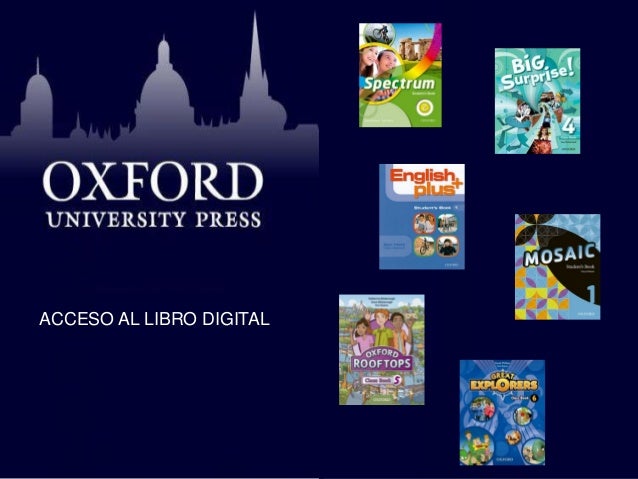
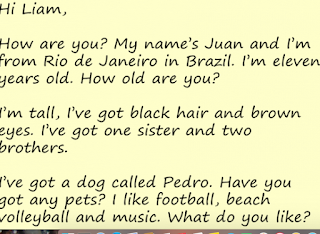
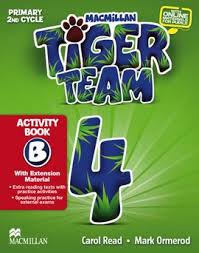
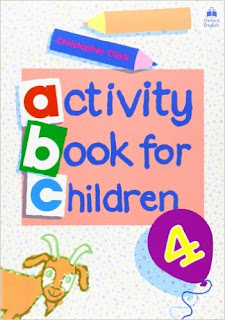





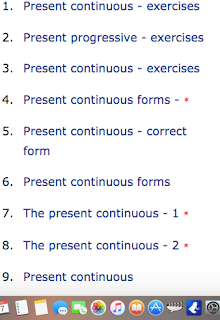
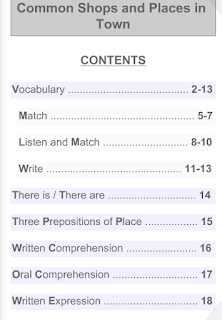
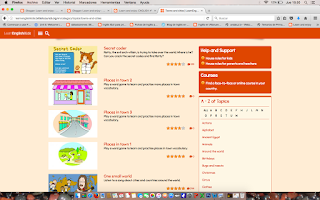
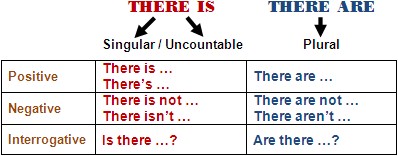












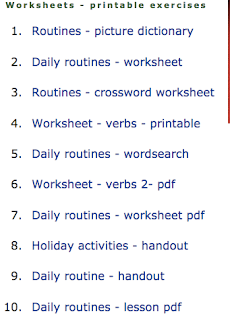
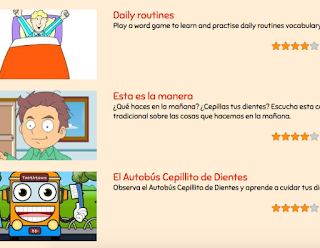

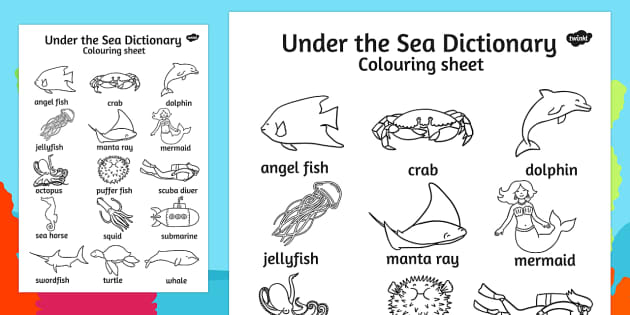
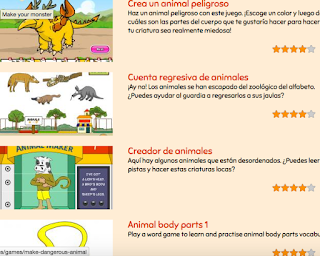
Buenísima ayuda,aprende jugando. Gracias seño
ResponderEliminarTHANK YOU VERY MUCH.
EliminarAprenden muchísimo, gracias seño
EliminarHola seño Andrea
ResponderEliminarSoy Aitor